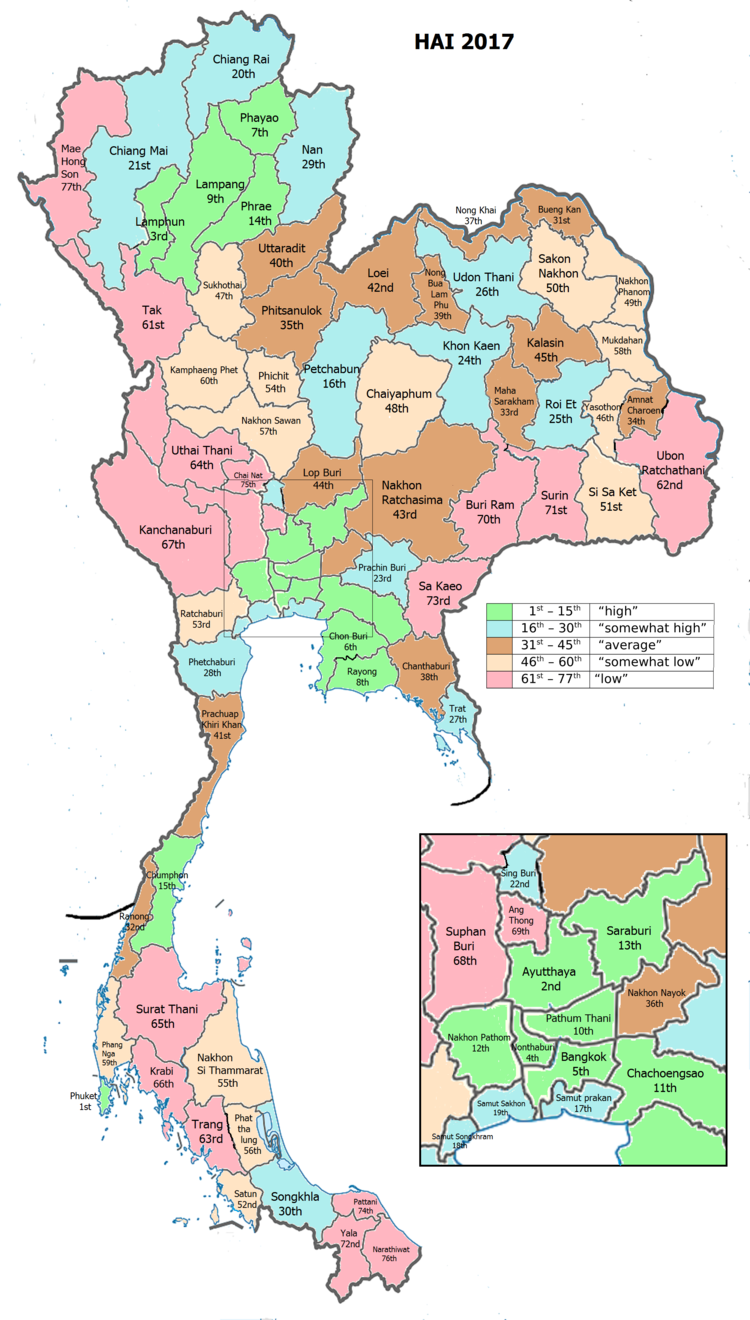world.wikisort.org - Thailand
Sing Buri (Thai: สิงห์บุรี, pronounced [sǐŋ būrīː]) is one of the central provinces (changwat) of Thailand.[4] Neighboring provinces are (from north clockwise) Nakhon Sawan, Lopburi, Ang Thong, Suphan Buri, and Chai Nat.
Sing Buri
สิงห์บุรี | |
|---|---|
Province | |
 Monument of eleven leaders of Khai Bangrachan | |
 Flag  Seal | |
| Motto(s): Land of heroes and courageous people, the reclining Buddha image, famous fish of Mae La, and the trading area of the central region | |
 Map of Thailand highlighting Sing Buri province | |
| Country | Thailand |
| Capital | Sing Buri town |
| Government | |
| • Governor | Chaichan Sittiwirattham (since 2021) |
| Area | |
| • Total | 822 km2 (317 sq mi) |
| • Rank | Ranked 74th |
| Population (2018)[2] | |
| • Total | 209,377 |
| • Rank | Ranked 75th |
| • Density | 254.7/km2 (660/sq mi) |
| • Rank | Ranked 13th |
| Human Achievement Index | |
| • HAI (2017) | 0.6111 "somewhat high" Ranked 22nd |
| Time zone | UTC+7 (ICT) |
| Postal code | 16xxx |
| Calling code | 036 |
| ISO 3166 code | TH-17 |
Toponymy
The word sing originates from Sanskrit singh meaning 'lion' and buri, from Sanskrit puri meaning buri mueang 'fortified city' or 'town'. Hence the literal translation is 'lion city', sharing the same root as Singapore.
Geography
Sing Buri is located on the flat river plain of the Chao Phraya River valley. Eighty percent of the areas are wide flat areas, of which the soil is suitable for agriculture. There are a small number of slopes in swamps of different sizes. The highest average height of the area is 17 meter above sea level. Floods will occur during the rainy season. The total forest area is 0.4 km2 (0.15 sq mi) or 0.5 per mille of provincial area.[5]
Climate
Sing Buri province has a tropical savanna climate (Köppen climate classification category Aw). Winters are dry and warm. Temperatures rise until May. The monsoon season runs from May through October, with heavy rain and somewhat cooler temperatures during the day, although nights remain warm. Climate statistics: the maximum temperature is 41.4 °C (106.5 °F) in April and the lowest temperature is 10.2 °C (50.4 °F) in December. The highest average temperature is 36.8 °C (98.2 °F) and the minimum average temperature is 20.6 °C (69.1 °F). Annual average rainfall is 1,125 millimeters with mean rainy days is 17.6 in September. Maximum daily rainfall is 203.4 millimeters in October.[6]
History
The area of Sing Buri held an important position in early Thai history from the Dvaravati period down to the Ayutthaya period. The city was originally on the banks of the Chaksi River. The first relocation was to the west of the Noi River (south of Sing Sutthara Temple) and later moved to Pak Bang Krathong, Ton Pho subdistrict. In 1869 the districts In Buri, Phrom Buri and Sing Buri were merged. In 1895 the three districts came under control of Krung Kao province ("Old capital"), monthon Krung Kao. In 1896 the city was moved to its final destination in Bang Phutsa subdistrict. In 1917 Mueang district changed its name to Bang Phutsa district.[7] In 1938 the government changed the name of the capital district to be the same as the name of the province. So Bang Phutsa district uses the name Mueang Sing Buri until today. In 1939 Sing district was renamed Bang Rachan district.[8]
Symbols

The provincial seal presents the history of Khai Bang Rachan. When the Burmese attacked Ayutthaya in 1765, 11 leaders with villagers from Bang Rachan fought the army when it stopped north of Ayutthaya. They managed to delay them for five months before they were finally defeated, soon thereafter Ayutthaya fell as well. Annually on 4 February a ceremony is held in remembrance of these local heroes. This story was also made into a movie in Thailand.
- Old seal was created in 1940, shows the fort Khai Bang Rachan.
- New seal was adopted in 2004, shows the eleven leaders who fought the Burmese.[9]
The provincial tree is the Red Sandalwood Tree (Adenanthera pavonina).
Administrative divisions

Provincial government
The province is divided into six districts (amphoes).[4] The districts are further subdivided into 45 subdistricts (tambons) and 364 villages (mubans).
Local government
As of 26 November 2019 there are:[10] one Sing Buri Provincial Administration Organisation (ongkan borihan suan changwat) and 8 municipal (thesaban) areas in the province. Sing Buri and Bang Rachan have town (thesaban mueang) status. Further 6 subdistrict municipalities (thesaban tambon). The non-municipal areas are administered by 33 Subdistrict Administrative Organisations - SAO (ongkan borihan suan tambon).[2]
Human achievement index 2017
| Health | Education | Employment | Income |
| 19 | 14 | 67 | 45 |
| Housing | Family | Transport | Participation |
 |
 |
 |
|
| 25 | 71 | 11 | 27 |
| Province Sing Buri, with an HAI 2017 value of 0.6111 is "somewhat high", occupies place 22 in the ranking. | |||
Since 2003, United Nations Development Programme (UNDP) in Thailand has tracked progress on human development at sub-national level using the Human achievement index (HAI), a composite index covering all the eight key areas of human development. National Economic and Social Development Board (NESDB) has taken over this task since 2017.[3]
| Rank | Classification |
| 1 - 15 | "high" |
| 16 - 30 | "somewhat high" |
| 31 - 45 | "average" |
| 45 - 60 | "somewhat low" |
| 61 - 77 | "low" |
| Map with provinces and HAI 2017 rankings |
 |
References
- Advancing Human Development through the ASEAN Community, Thailand Human Development Report 2014, table 0:Basic Data (PDF) (Report). United Nations Development Programme (UNDP) Thailand. pp. 134–135. ISBN 978-974-680-368-7. Retrieved 17 January 2016, Data has been supplied by Land Development Department, Ministry of Agriculture and Cooperatives, at Wayback Machine.
{{cite report}}: CS1 maint: postscript (link)[dead link] - "รายงานสถิติจำนวนประชากรและบ้านประจำปี พ.ศ.2561" [Statistics, population and house statistics for the year 2018]. Registration Office Department of the Interior, Ministry of the Interior (in Thai). 31 December 2018. Retrieved 20 June 2019.
- Human achievement index 2017 by National Economic and Social Development Board (NESDB), pages 1-40, maps 1-9, retrieved 14 September 2019, ISBN 978-974-9769-33-1
- "Sing Buri". Tourism Authority of Thailand (TAT). Retrieved 6 May 2015.
- "ตารางที่ 2 พี้นที่ป่าไม้ แยกรายจังหวัด พ.ศ.2562" [Table 2 Forest area Separate province year 2019]. Royal Forest Department (in Thai). 2019. Retrieved 6 April 2021, information, Forest statistics Year 2019
{{cite web}}: CS1 maint: postscript (link) - "Climatological Data for the Period 1981-2010". Thai Meteorological Department. p. 15. Retrieved 22 December 2019, station Lopburi is at 30 km distance from Sing Buri
{{cite web}}: CS1 maint: postscript (link) - "ประกาศเรืองเปลียนชืออาเภอ" [Announcement of changed district names] (PDF). Royal Thai Government Gazette. 34: 40–68. 29 April 1917. Retrieved 15 November 2019, page 42
{{cite journal}}: CS1 maint: postscript (link) - "พระราชกฤษฎีกา เปลี่ยนนามอำเภอ กิ่งอำเภอ และตำบลบางแห่ง พุทธศักราช ๒๔๘๒" [Royal Decree Change name of Amphoe, King amphoe and Tambon village, Buddhist Era 2482 (1939)] (PDF). Royal Thai Government Gazette. 56: 354–363. 17 April 1939. Retrieved 22 December 2019, page 362
{{cite journal}}: CS1 maint: postscript (link) - http://www.ratchakitcha.soc.go.th/DATA/PDF/2547/E/129/001.PDF [bare URL PDF]
- "Number of local government organizations by province". dla.go.th. Department of Local Administration (DLA). 26 November 2019. Retrieved 10 December 2019.
65 Sing Buri: 1 PAO, 2 Town mun., 6 Subdistrict mun., 33 SAO.
External links
 Sing Buri travel guide from Wikivoyage
Sing Buri travel guide from Wikivoyage- Website of province (Thai)
- Singburi provincial map, coat of arms and postal stamp Archived October 6, 2010, at the Wayback Machine
Другой контент может иметь иную лицензию. Перед использованием материалов сайта WikiSort.org внимательно изучите правила лицензирования конкретных элементов наполнения сайта.
WikiSort.org - проект по пересортировке и дополнению контента Википедии